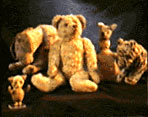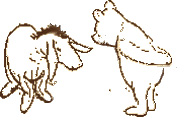
Winnie The Pooh-History Of The REAL Pooh
“Behind Every Great Man (Or Bear)…”
In 1920, Daphne Milne bought a large mohair teddy bear for her one year old son, Christopher, from the famous London department store, Harrods. As the English firm of JK Farnell was the exclusive supplier of teddies to Harrods, it is most likely that Farnell made Winnie-The-Pooh. There would be many other similar bears around the world! A big family of “Poohs” under different names!
Christopher first named his teddy ‘Edward Bear’, but renamed him “Winnie” after an American black bear he loved to visit in London Zoo. Donated by a Canadian, Lieutenant Harry Colbourn, Winnie had been bought as a cub from a Canadian hunter during WW1 and bought to England when Lt Colbourn’s army unit was enroute to France. She stayed at the zoo during the war but remained there for the rest of her life, having become a favourite ‘friend’ to visitors.
‘Pooh’ was a swan that the Milnes visited in the English countryside, and of whom Christopher was very fond.
Winnie The Pooh became a character in the family’s social life! Christopher personified his bear with conversations, which with other animals from his nursery, became characters in a series of little incidents that Mr and Mrs Milne, and their friends, enacted for a laugh! These other animals included a donkey (a Christmas present to Christopher, named Eeyore), and a piglet (a gift from neighbours in Chelsea). ‘Tigger’ the tiger, ‘Kanga’ and “Roo’ were also added in 1925 and 1926. These incidents inspired AA Milne to bring them to literary life in his poems and stories. He set these stories in Ashdown Forest, Sussex, a mile from a country home the family bought; the ‘Hundred Acre Wood’ was based on the ‘Five Hundred Acre Wood’ within the forest.
Christopher Robin himself though, pointed out that he believed his mother provided his father with much of the material for his books, as it was she who predominately played with him, and relayed the stories of their play to his father.
A Star Is Born
 Edward Bear first appeared in a poem in ‘When We Were Very Young’, published in 1924. Pooh the swan was also a character in this book of verse. The London Evening News, though, published a story in Dec. 1925, in which Milne had used Christopher’s new name for his bear, for the central character, Winnie The Pooh. His first book about the teddy, ‘Winnie The Pooh’ was published in 1926 by Methuen, starring ‘Winnie The Pooh’ in a collection of stories.
Edward Bear first appeared in a poem in ‘When We Were Very Young’, published in 1924. Pooh the swan was also a character in this book of verse. The London Evening News, though, published a story in Dec. 1925, in which Milne had used Christopher’s new name for his bear, for the central character, Winnie The Pooh. His first book about the teddy, ‘Winnie The Pooh’ was published in 1926 by Methuen, starring ‘Winnie The Pooh’ in a collection of stories.
Will The Real Pooh Bear Please Stand Up?
Ernest Shephard illustrated ‘Winnie The Pooh’, and it is his lovely line drawings that became the original image that readers knew to be Pooh. He didn’t, though, base his illustrations on Christopher Robin’s bear, but on his own son’s teddy, named Grisly.
On June 16th, 1961, Disney acquired the rights to Pooh. In the three subsequent years the Disney animators rewrote and redrew the Milne books producing ‘Winnie The Pooh And The Honey Tree’. Unfortunately, all traces of Pooh’s British heritage were meticulously erased. Christopher Robin was considered too ‘sissy’. Lyrics were reworded by the Sherman Brothers. The character image of Pooh readily available today is a variant of that created by Disney. Originally Pooh’s name was hyphenated (Winnie-The-Pooh) and these were dropped. ‘Gopher’ replaced ‘Mole’, so as to be more familiar to American children. It is a thought though that being presented with ‘exotic’ new animals and foreign accents would have added to the enchantment of Pooh and his world.
The Real Toys
In 1947 AA Milne agreed to allow the toys to tour the US, arranged by the US publishers of his work, Dutton Publishing. The tour lasted ten years, before Dutton convinced Milne to allow the family of toys to remain in America. As of Sept 11th, 1987, they now reside in a large glass case in the New York City Library. Roo, though, disappeared in Sussex before the tour, probably taken for a ‘walk’ by the family dog!
It is uncertain whether the toys will ever travel back home to The Hundred Acre Wood and to Christopher Robin.
Christopher distanced himself early on from the glare of the world’s spotlight, and ran a small bookshop in Devon, in country England. In 1952 he wrote two autobiographical works, ‘The Enchanted Places’ and ‘Path Through The Trees’, the process of which helped him to feel more at ease with his fame. He died on April 20th, 1996, aged 76, after a long battle with myasthenia gravis, an autoimmune neuromuscular disease.







